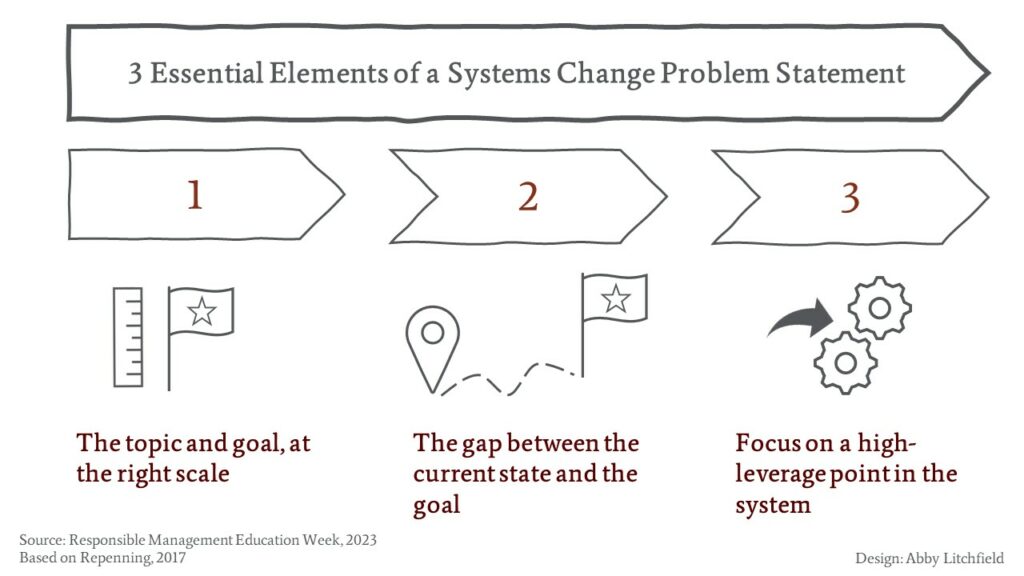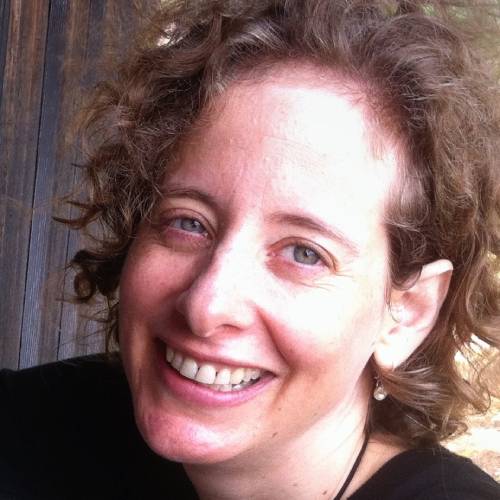Challenges like climate change and biodiversity loss can be tough to tackle. Here’s a model for taking the first step.
Sustainability issues can feel overwhelming.
But they get more manageable when you have tools to tackle them and a group to support you.
That was the conclusion of a day-long workshop: “Systems Change for Sustainability: Connecting and Collaborating on Grand Challenges.” The workshop brought together over 100 business school faculty and staff committed to sustainability. It was co-organized by the NBS Sustainability Centres Community as part of “Responsible Management Education Week” in New York.
The workshop aimed to demystify systems change, providing structured ways to address complex sustainability issues. The day also built community, as participants filled the room with passion and energy. Such connecting is an essential part of enabling change, said workshop co-lead Jason Jay of MIT Sloan. After all, no single individual can solve a systemic problem like climate change. But when many individuals focus on many different elements of a problem, their collective efforts can change the system.
Jay and co-lead Jury Gualandris (Network for Business Sustainability) structured the workshop to provide a template for action as well as opportunities to raise and share critical issues. This article captures those action steps and some of the projects discussed at the workshop.
Do You Work on Systems Change?
People don’t always use “systems” language to describe the issues they work on. How do you know if you’re working on changing a system? In an earlier webinar, Gualandris and Jay defined systems change as it relates to business schools.
Fundamentally: Systems thinking is about recognizing the complexity of our world. Almost any sustainability issue qualifies as a systems problem, meaning that it can’t be addressed without considering many interlocking elements.
Business schools use many tools to influence real-world socio-technical systems, including applied research, targeted learning experiences, engaged scholarship, action learning, and partnerships. “Fundamentally, we’re interested in any project that clarifies or initiates paths to change,” said Gualandris.
The concept of systems change now resonates with workshop participant Betina Szkudlarek (University of Sydney). “We try to implement change through everything we do,” she commented. “I never called it the systems perspective but I realize now that’s what it is.”
Here are some examples of systems change projects participants are working on, from a recent survey. Details on these projects, and more responses to the survey, are available here.
-
Just transition and climate leadership, through a partnership of African business schools – Jill Bogie, Gordon Institute of Business Science
-
Supporting decent and dignified work, using the Minimum Income Standard methodology – Christiane Molina, ESADE Business School
-
Addressing ocean problems (SDG 14) through innovation – Dan Vermeer, Duke University
-
Reducing Scope 3 emissions due to university travel – Heather Ranson, Gustavson School of Business
Steps to Action: How to Change a System in Three Months
Why focus on a three-month plan? Breaking systems change efforts into smaller projects and actions supports both learning and action. The feedback from short-term outcomes spurs learning. Meanwhile, well-chosen projects “initiate a chain of reactions that can ripple through the system,” said Gualandris.
Jay and Gualandris shared a strategy focused on structured problem solving, an approach developed by Nelson Repenning of MIT. It’s a way to “develop a logical argument that links the observed data to root causes and, eventually, to a solution,” wrote Repenning. The structure lets people think through issues methodically, but also leaves space for inspiration and intuition.
Practically, workshop participants focused on creating clear problem statements. Problem statements have a few essential elements. They include (1) the topic and goal at the right scale, and (2) a statement of the gap between the current state and the goal. They also (3) prioritize action that will have an impact, focused on high-leverage points in the system.
Participant Christiane Molina (EGADE Business school) commented on the value of this approach: “At the beginning of this day, I started with a big complex problem. The way you conducted the workshop, I ended up with a problem for which I have a three-month plan or goal. This method brings something that seems far away close to us.”
Here’s more detail on each essential element of a problem statement (and Repenning’s article has even more guidance):
1. The topic and goal, at the right scale
“We ultimately want a sustainable world, which is what brings us all into the room,” said Jay. But sustainability problems are “nested,” with big goals like addressing climate change resting on relatively smaller actions like developing more renewable energy or making companies more efficient.
To frame actions that can be completed in three months, think about problem statements at a “medium” level, Jay and Gualandris recommended. That means an action that is bigger than a single experiment but smaller than “a sustainable world.”
Ideally, a project will first formulate the big problem in terms of the gap between the current state and the goal state. Then, scope down the main problem to sub-problems. Look perhaps at a time frame of 1-2 years, and then at a problem that can be tackled in three months.
2. The gap between the current state and the goal
Try to be explicit about the distance between the present state of the problem and the goal. Identifying that gap helps you chart progress. It can also be motivating: research shows that this kind of contrast is more likely to lead people to change than focusing only on the future or on current challenges.”
It’s more important to know the direction of change than to have detailed metrics, Jay explained during the workshop. You’re creating a tension – between current and desired state — that can drive action.
3. Focus on a high-leverage point in the system
Action strategies should build on what we know about intervening in systems. In particular, recognize that some elements of systems are most fundamental, and thus a pre-requisite for other changes. As shown in the diagram, these fundamental elements are mental models (mindsets), relationships, and power dynamics. They represent “transformative” and “relational” change. Policies, practices, and resource flows are “structural” changes that are unlikely to happen without the other, more fundamental shifts.

For example: Carbon pricing is a policy approach that is gaining momentum but hasn’t been adopted as widely as we need. If power dynamics change (e.g. through a grassroots climate movement electing new representatives), policies could as well. Both of these require a shift in mental models – it shouldn’t be free to pollute the atmosphere and harm the climate.
Intervening at these more fundamental levels is “high leverage,” with a big potential result for the action.
Getting to a Project Statement: The Example of Agri-Food Systems
Here’s an example of how to develop a problem statement, from Jury Gualandris.
His topic and goal relate to shifting agriculture from a source of problems (chemicals, carbon emissions, biodiversity loss) to a source of solutions (ecosystem services that sequester carbon, retain and filter water, and restore biodiversity). Increasing regenerative agriculture is an important way to do that.
What’s the gap between the current state and the goal state? Acres being managed regeneratively would need to increase by 30%, by some estimates.
Jury wants to pursue this goal through an applied research project, focused on a high-leverage point in the system. “I must consider ways to create collective action via nudging the mindsets of farmers,” he says. For a three-month project, he will try to motivate a consortium of academic and industry collaborators to work together to create tools to nudge mindsets. “Building the consortium is still a challenging task, but it can be digested and executed within a short time frame.”
A formal problem statement might be: “We want to shift agriculture from a source of problems to a source of solutions, through a 30% increase in the number of acres managed regeneratively. Our applied research focuses on creating collective action by nudging farmers in this direction. But, by scoping down our problem statement, we realized the need to develop new tools to nudge farmers effectively. Hence, in the next three months, we will engage a consortium of collaborators to develop these tools.”
Learning from Each Other: Change Is Underway
The workshop offered new strategies for approaching systems. But it also celebrated the amazing work being done already.
Participants in the workshop shared their innovative and powerful projects on different aspects of sustainability. Some projects transformed the business school itself: its curriculum, research and engagement processes. Others focused on outreach – engaging with local and global stakeholders to drive broader change.
Before the workshop, participants and other academics completed a survey on their existing sustainability projects. See the full set of responses for information, inspiration, and potential opportunities for collaboration:
During the workshop, individuals also organized into groups focused on issues identified through voting and ranking. The graphic below shows these emergent topics, with font size corresponding to votes.

Working with these topics, participants developed problem statements and also shared their stories, experiences, and knowledge.
Reflections on Changing Systems
Throughout the day, workshop participants paused for meditation, reflection, and feedback. They responded to questions like “What do you want to remember today” and “What will you do next?”
Here are some of the insights shared in plenary sessions, grouped by theme.
Thank You and Acknowledgements
Many thanks to the participants, leaders, and organizers of the workshop. MIT Sloan’s Sustainability Initiative and the Network for Business Sustainability co-organized the systems change event, and partnered with the United Nations Principles of Responsible Management Education on Responsible Management Education Week. The Sustainability Centres Community Advisory Board provided wise guidance. Fordham University provided space and the University of Michigan’s Erb Institute supported travel bursaries for attendees from developing countries.
Thanks also to the marvelous MIT and NBS teams who helped shape this article, and to everyone quoted for their wise statements.
More about Responsible Management Education Week
While the Systems Workshop wasn’t recorded, pictures are available here.
Explore additional outputs from sessions facilitated by the Sustainability Centres Community, from tips on running a sustainability centre to musical performance.
Pictures from earlier in Responsible Management Education Week are also online. (These photos have the following credit: (C) PRME / Joel S Photo LLC) . Plenary sessions from earlier in Responsible Management Education week are available on the PRME YouTube channel.





Add a Comment
This site uses User Verification plugin to reduce spam. See how your comment data is processed.This site uses User Verification plugin to reduce spam. See how your comment data is processed.